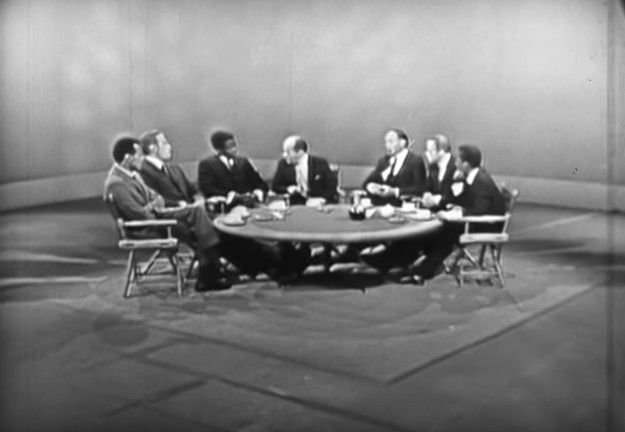Hollywood Roundtable: Civil Rights
ca. 1963
Add to Favorites:
Add all page(s) of this document to activity:

In this film created by the U.S. Information Agency (USIA), celebrities who attended the March on Washington discuss civil rights.
The USIA made films to influence public opinion about the United States abroad. In 1948, Congress had passed the Smith-Mundt Act that allowed the United States to spread information to foreign countries during times of peace. The act also prohibited the distribution of information within the United States.
By the 1950s, Soviet information agencies were spreading their beliefs around the world. When it became evident that the Unied States was losing the "war of ideas," the need to spread information grew stronger. In 1953, President Eisenhower created the USIA. The agency was designed to make foreign nations more receptive to U.S. foreign policy.
As Cold War tensions escalated, the desire to spread American ideas only increased. In the early 1960s, President John F. Kennedy appointed media icon Edward R. Murrow to lead the USIA and increased the agency’s budget dramatically.
Yet the USIA still faced the monumental task of convincing skeptical foreign nations that their government should embody the principles of the United States. This message was especially difficult to convey while hundreds of thousands of Americans were protesting during Civil Rights Movement.
On August 28, 1963, hundreds of thousands of people gathered in Washington D.C. to "March for Jobs and Freedom," known as the March on Washington. Since the world was already aware of the March on Washington, USIA directors had no choice but to embrace the event. The USIA produced multiple films about the March, all of which focused on the advancement of minority rights through the inherently American principle of free speech.
The March on Washington was attended and organized by many celebrities. Harry Belafonte, Bob Dylan, Joan Baez, Marlon Brando, Charlton Heston, Sidney Poitier, Sammy Davis Jr., Jackie Robinson, James Baldwin, Joseph Mankiewicz, Burt Lancaster, Paul Newman and many others were in attendance. In this film made following the March, some of these celebrities gathered in front of USIA cameras to share their thoughts about the March on Washington and the Civil Rights Movement in general.
You can also watch this film in our main National Archives online catalog.
The USIA made films to influence public opinion about the United States abroad. In 1948, Congress had passed the Smith-Mundt Act that allowed the United States to spread information to foreign countries during times of peace. The act also prohibited the distribution of information within the United States.
By the 1950s, Soviet information agencies were spreading their beliefs around the world. When it became evident that the Unied States was losing the "war of ideas," the need to spread information grew stronger. In 1953, President Eisenhower created the USIA. The agency was designed to make foreign nations more receptive to U.S. foreign policy.
As Cold War tensions escalated, the desire to spread American ideas only increased. In the early 1960s, President John F. Kennedy appointed media icon Edward R. Murrow to lead the USIA and increased the agency’s budget dramatically.
Yet the USIA still faced the monumental task of convincing skeptical foreign nations that their government should embody the principles of the United States. This message was especially difficult to convey while hundreds of thousands of Americans were protesting during Civil Rights Movement.
On August 28, 1963, hundreds of thousands of people gathered in Washington D.C. to "March for Jobs and Freedom," known as the March on Washington. Since the world was already aware of the March on Washington, USIA directors had no choice but to embrace the event. The USIA produced multiple films about the March, all of which focused on the advancement of minority rights through the inherently American principle of free speech.
The March on Washington was attended and organized by many celebrities. Harry Belafonte, Bob Dylan, Joan Baez, Marlon Brando, Charlton Heston, Sidney Poitier, Sammy Davis Jr., Jackie Robinson, James Baldwin, Joseph Mankiewicz, Burt Lancaster, Paul Newman and many others were in attendance. In this film made following the March, some of these celebrities gathered in front of USIA cameras to share their thoughts about the March on Washington and the Civil Rights Movement in general.
You can also watch this film in our main National Archives online catalog.
This primary source comes from the Records of the U.S. Information Agency.
National Archives Identifier: 48331
Full Citation: Motion Picture 306-1757; Hollywood Roundtable: Civil Rights; ca. 1963; Moving Images Relating to U.S. Domestic and International Activities , 1982 - 1999; Records of the U.S. Information Agency, Record Group 306; National Archives at College Park, College Park, MD. [Online Version, https://www.docsteach.org/documents/document/hollywood-round-table-civil-rights, April 26, 2024]Rights: Copyright Not Evaluated Learn more on our privacy and legal page.



